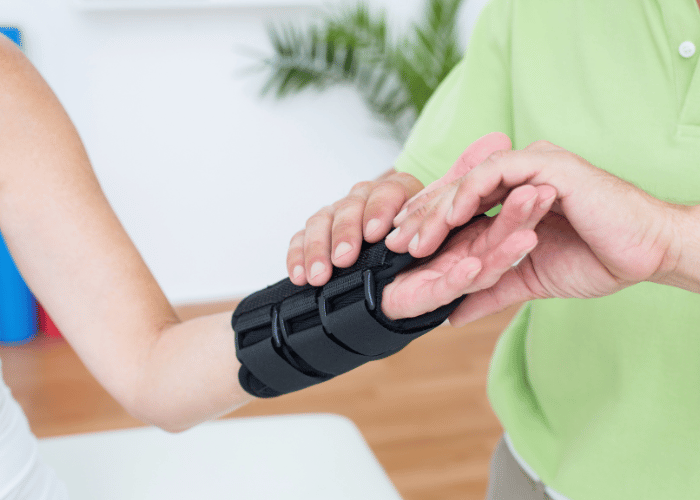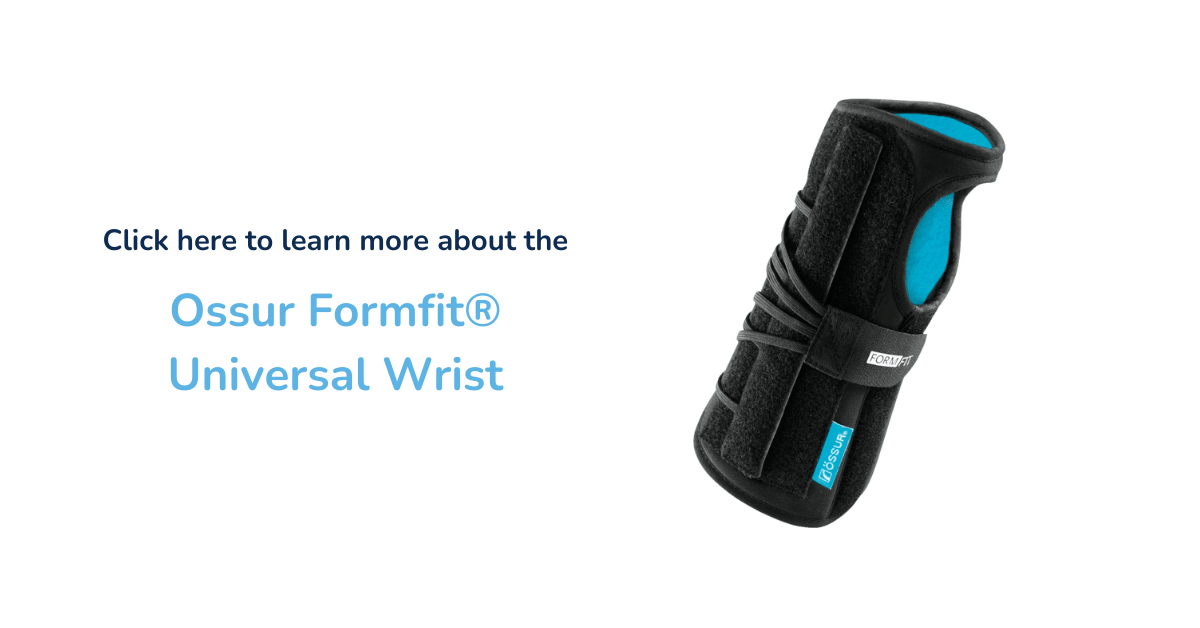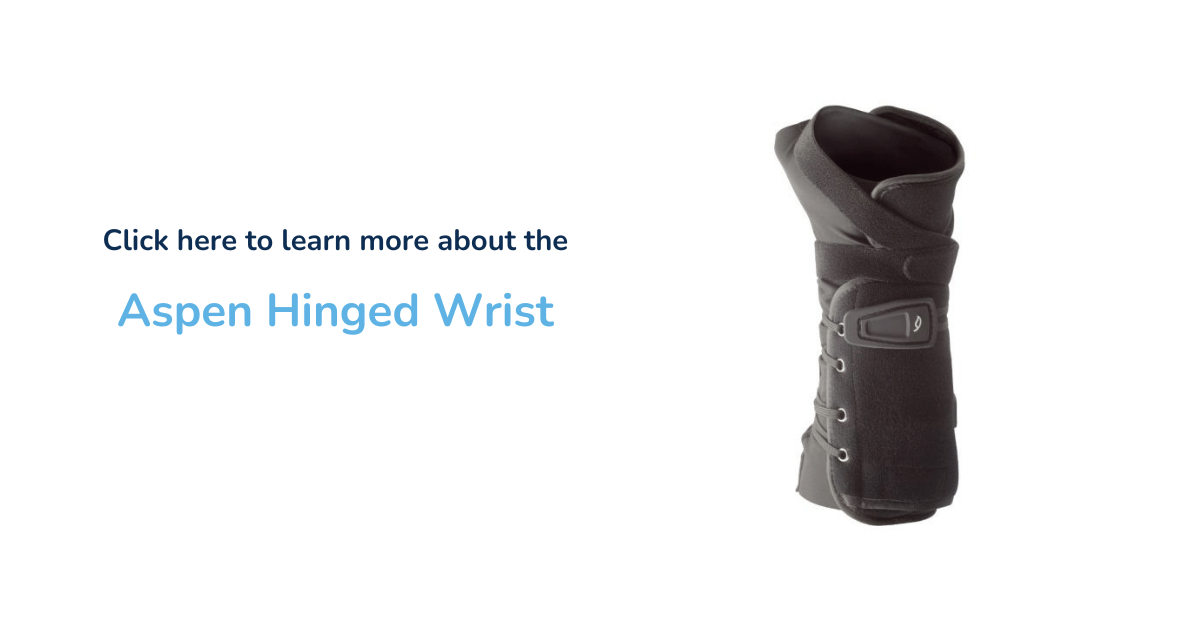Carpal Tunnel Syndrome
Carpal tunnel syndrome occurs when the median nerve is compressed between the carpal bones and the transverse carpal ligament. You may experience a tingling sensation, numbness, or irritation when the median nerve is irritated or compressed. Symptoms are initially noticed in the dominant hand during early stages of symptom onset.
We will review the causes, symptoms, and treatment options for carpal tunnel syndrome in this blog article.
What Is Carpal Tunnel Syndrome?
The carpal tunnel is comprised of the wrist bones located on the palm side and the transverse carpal ligament. These structures form the carpal tunnel which the median nerve and tendons passes through. Swelling of the tendons or irritation of the synovial sheath cause compression on the median nerve. Compression and irritation can also be caused by damage to the carpal tunnel.
Feeling to the thumb, index, middle, and part of the ring finger is provided by the median nerve. Symptoms are noticed in these fingers when the median nerve is compressed or irritated. Carpal tunnel syndrome is the most common of the entrapment neuropathies which occurs when a peripheral nerve is pressed or squeezed.
.png?width=3053&height=1756&name=carpel%20tunnel%20anatomy%20(4).png)
Risk Factors
You may be at risk for wrist tendinitis based on your daily activities or lifestyle choices that negatively impact your health. Other risk factors include:
- Individuals who perform repetitive hand motions
- Incorrect arm or hand position when typing, texting, or performing hand intensive work activities
- Health issues such as osteoarthritis, rheumatoid arthritis, diabetes, obesity, and thyroid gland imbalance
- Poor joint and bone structure
- Women, and individuals over 40 years old
- Wrist trauma such as fracture or dislocation
- Cyst or tumor in the carpal tunnel
Symptoms
Symptoms are typically mild in the beginning and become progressively worse. Early onset symptoms are most noticeable at night and include:
- Numbness
- Swollen fingers
- Tingling (pins and needles feeling) or pain sensation in the fingers
As symptoms progress they become noticeable during the day and include:
- Difficulty and pain performing daily tasks while gripping objects
- Weak grip
- Pain in the fingers during the day that progressively becomes worse at night
- Loss of finger movement, or difficulty moving fingers
- Pain or tingling (pins and needles feeling) that travels from the fingers up the forearm
We discuss some tips for communicating with your doctor at your next appointment in a previous blog. You may find the information in this blog helpful for your next visit. Another blog we suggest before your next visit discusses how to talk to your doctor about pain.
Diagnosis
Your healthcare provider will perform a physical examination on your wrist and hand during your visit. You will also be asked about your medical history and symptoms.
The physical examination typically includes rotating your hand and making a fist to determine where the pain originates. Other physical evaluations include the following:
- Applying pressure and tapping to the median nerve (Tinel test)
- Flexing the wrist to the maximum positions and checking for pain, tingling, or numbness
- Testing the sensitivity of your thumb, index, and ring fingers
- Determine if the muscles at the base of your thumb are weak or atrophied
- Electrophysiological tests of the median nerve to determine the severity and if other nerves are involved (Electromyography, nerve conduction study)
Other tests may be ordered by your healthcare provider to determine the severity of your nerve compression and if other medical conditions are contributing to the condition. These include MRI, X-Ray, and Ultrasound tests.
.png?width=700&height=400&name=doctor%20examining%20patient%20wrist(1).png)
Treatment
Many conservative treatment options are available if you are suffering from carpal tunnel syndrome. Treatments range from physical therapy to rest. Invasive surgical options should be reserved until you have exhausted all conservative treatment options and the pain makes it difficult or impossible to perform daily activities.
Treatment Options
Treatment options include:
- Rest
- RICE (Rest, Ice, Compression, Elevation)
- Medication such as nonsteroidal anti-inflammatory drugs (NSAIDs) or steroid injections
- Physical therapy
- Occupational therapy
- Change or modify activities that aggravate the median nerve
- Wrist brace for sleeping and strenuous hand activities
Your healthcare provider may recommend surgery if conservative treatment options are unsuccessful. The carpal tunnel release surgery may be necessary to avoid permanent nerve damage non-invasive treatments do not relieve the conditions. A wrist brace is recommended post-surgery.
Prevention
Maintaining a healthy lifestyle and avoiding overuse of your wrist can minimize carpal tunnel syndrome episodes. Other preventive actions such as awareness of your wrist position and managing unhealthy habits is also helpful. Be sure your diet and supplements include vitamins and minerals that maintain healthy tendons, bones, and muscles.
Stretching your hands prior to performing activities that are physically demanding on your wrists allow your hands and wrists to acclimate prior to heavy use. It is advisable to stretch and take frequent breaks if you perform physical activities at work involving your hands and wrists.
A wrist brace is helpful if you engage in demanding physical activities involving your hands and wrists. The physical strain of these activities can be minimized through the use of a wrist brace.
Wrist Braces
A wrist brace is useful to immobilize the wrist during healing. Your wrist will be supported by the wrist brace and movement will be restricted. This is important during sleep to avoid over-extending your wrist or placing the wrist in a position that will cause median nerve inflammation. Wearing a wrist brace during sleep will support your wrist and keep it in a neutral position which are important for relieving nerve and tendon inflammation and to promote healing.

Wearing a wrist brace during the day while performing repetitive wrist motions will help protect your wrist. A wrist brace is also useful for activities that strain the wrist or when lifting heavy items.
We're Here to Help
The team of experts at Elite Medical Supply is here to help identify the right wrist brace for your carpal tunnel syndrome and recovery. We offer a wide selection of braces from world-class manufacturers to help alleviate the pain and heal your carpal tunnel. Take a look at our selection of wrist braces by clicking here.
When you're ready to order a brace or need assistance making a choice we're here to help. You can reach us at 866-712-0881, send us an email, or fill out a contact form.
Written by Elite Medical Supply of NY
Braces and Products Covered by Medicare
Browse ProductsRecent Posts
- Cervical Brachial Syndrome (Thoracic Outlet Syndrome): What You Need to Know
- Spinal Decompression at Home: What It Is, How It Works, and Whether It’s Right for You
- Manage Osteoarthritis Progression With a Quality Knee Brace
- Product Highlight: Aspen Active™ P-TLSO
- Understanding Radiculopathy: Causes, Symptoms, & Treatment Options
Topics
- Back Braces (39)
- Knee Braces (31)
- Medicare Beneficiaries (31)
- Pain (25)
- Non-Opioid (23)
- Medical Providers (19)
- Lower back pain (11)
- Product Highlight (11)
- Sciatica (11)
- Muscle Spasms (10)
- Decompression (9)
- Lumbago (8)
- Degenerative disc disease (6)
- Lumbar Spinal Stenosis (6)
- Spinal Stenosis (6)
- Working with your doctor (6)
- Fracture healing (5)
- Herniated Nucleus Pulposus (5)
- Bulging or herniated disc (4)
- Neuromuscular Electrical Stimulation (NMES) (4)
- Quadratus Lumborum Syndrome (4)
- SI Joint (4)
- SI Joint Dysfunction (4)
- Spondylolysis (4)
- Wrist Pain (4)
- Bone Growth Stimulator Therapy (3)
- Bone Growth Stimulators (3)
- Carpal Tunnel Syndrome (3)
- Kyphosis (3)
- Supine Cervical Traction (3)
- Unicompartmental Osteoarthritis (OA) (3)
- Wrist Brace (3)
- wrist tendinitis (3)
- Ambulatory Cervical Traction (2)
- Braces for Golf (2)
- Cervical Traction (2)
- Electrical Stimulation (2)
- Failed Spinal Fusion Syndrome (2)
- Lumbar compression fractures (2)
- Radiculopathy (2)
- Spondylolisthesis (2)
- Total Knee Replacement (2)
- Wrist Braces (2)
- Arthritis (1)
- Braces for skiing (1)
- Cervical Brachial Syndrome (1)
- De Quervain Syndrome (1)
- Digital DME Orders (1)
- Knee Brace Accessory (1)
- Knee Suspension Wrap (1)
- Knee brace support for skiing (1)
- Medicare Scam (1)
- Muscle Atrophy (1)
- PCL (1)
- Patellofemoral Pain Syndrome (1)
- TLSO (1)
- Thoracic Outlet Syndrome (1)
- Ulnar Tendinitis (1)


